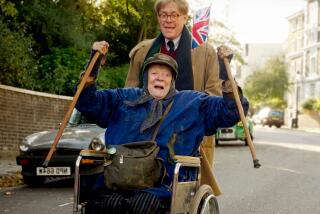Swept up by a timely turn of the tide
- Share via
Charles Dance’s “Ladies in Lavender” teams two of Britain’s grandest dames, Judi Dench and Maggie Smith, in an endearing film of subtlety and charm. This lovely period picture, set in Cornwall in 1936, also boasts the inimitable Miriam Margolyes and David Warner. It is a pleasure from start to finish.
On a sunny summer day a nearly drowned young man (Daniel Bruhl) is washed ashore on a craggy beach, where he is discovered by two spinster sisters who share a fine old stone manor house on the cliff above. Dench’s Ursula and Smith’s Janet are around 70 in an era when at that age women in Britain, as in America, were regarded by themselves -- and everyone else -- as “old ladies” and dressed and behaved accordingly. They are therefore leading very quiet lives indeed and deeply settled into routines, attended by their crusty but loyal housekeeper (Margolyes), when this stranger appears.
They immediately set about rescuing him, calling in the local doctor (Warner) to treat the youth and set his broken ankle. It seems he is a Polish Jew and a violin virtuoso who was swept overboard from a ship bound for America. He speaks no English but does speak German, a language in which Janet is a little rusty but with the aid of a German-English dictionary can communicate with him pretty well.
Bruhl’s Andrea Marowski is sweet-natured and boyish, and his impact on the sisters Widdington, Ursula especially, is immediate. Ursula has never known love -- Janet lost her fiance in World War 1-- and she is overcome by romantic stirrings while Andrea soon appeals to the astringent Janet’s maternal instincts. The feelings Andrea stirs up in the sisters are nothing they believe they can’t handle sensibly, yet at the same time they cannot bring themselves to contemplate the possibility that at some point Andrea almost inevitably will be moving on.
Complications set in when an elegant Russian watercolor artist (Natascha McElhone), while on a painting holiday to Cornwall, becomes aware of Andrea’s musical gifts, and Warner’s Dr. Mead, a lonely widower, becomes jealous of the artist’s interest in Andrea, not knowing that it is restricted to his talent.
Dench and Smith have known and worked together off and on since 1958, and it is of course a joy to watch two consummate actresses play off each other so effortlessly.
Ursula and Janet are two very real, fully dimensioned women who as sisters have learned to be very supportive of one another and never let ruffled feelings distance them for long. Their Widdington sisters are part of a sturdy, hearty community of farmers and fishermen who gradually learn to accept Andrea in their midst.
In reworking a William J. Locke short story, Dance, an estimable actor (perhaps best known for his gallant D.W. Griffith in the Tavianis’ “Good Morning, Babylon”) in his writing and directing debut overreaches a little in bringing “Ladies in Lavender” to a rather hectic conclusion. Even so, he achieves an emotional impact that has been well earned.
*
‘Ladies in Lavender’
MPAA rating: PG-13 for brief strong language
Times guidelines: Mature themes
An IDP release of a Roadside Attractions presentation. Writer-director Charles Dance. Based on a short story by William J. Locke. Producers Nicolas Brown, Elizabeth Karlsen, Nik Powell. Cinematographer Peter Biziou. Editor Michael Parker. Running time: 1 hour, 44 minutes.
At selected theaters.


